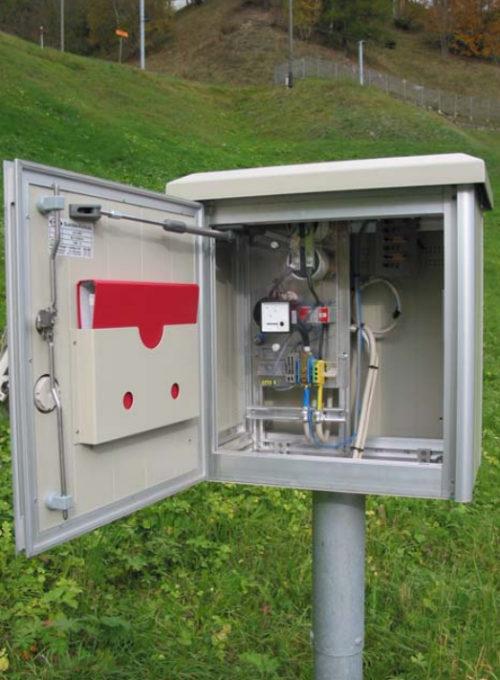Lightning and surge protection of the CCPS, protection against AC corrosion
Corrosion occurs between the earth and bare steel pipes through an electrochemical process. The earth acts as an electrolyte. Iron ions dissolve with the electrolyte and rust (iron oxide) is formed. Metallic pipelines that are laid in the ground must therefore be protected against corrosion.
This is done by:
a.) Coating of the metallic surface with plastic (formerly bitumen)
b.) Active cathodic corrosion protection (CCP):
By applying a direct voltage in the low-voltage range, the current flow of the electrochemical process is reversed. As a result, the iron ions can no longer dissolve. Corrosion is permanently prevented. The DC voltage is generated by an AC-powered rectifier. The metal tube is connected to the – pole, the special anode buried deep in the ground (long life, low resistance, ideal is approx. 1 Ω) with the + pole of the KKS rectifier.
In order to reliably protect the KKS against the effects of lightning, extensive lightning and surge protection must be provided. Both on the AC side (PowerPro BCD…) and on the DC side of the CCP (EnerPro… .and DataPro…, with integrated low-pass filter against HF harmonics, caused by the lightning…. = HF event!)
The pipeline is divided into sectors that limit the scope of the CCP. This requires insulating flanges or insulating pieces (for small diameters).
In the event of lightning, the insulating flange must be bridged (lightning protection equipotential bonding) to prevent electrical breakdown and destruction of the insulation. This is done by means of special lightning current-resistant, hermetically sealed, high-performance isolating spark gaps filled with inert gas (100kA 10/350µs) with fail-safe. The fail-safe function prevents mechanical destruction in the event of overload.
With explosive media such natural gas must be used with an ATEX certified isolating spark gap (TC 100 A) with low response voltage (70V AC / 100V DC) and fail-safe when laying above ground or underground. ATEX certification of the isolating spark gap is not required for underground installation, which is why the waterproof SGO 70/100 QA isolating spark gap is preferably used there.
The pipeline thus acts as a grounding conductor when lightning strikes through the bridged insulating flanges. After certain distances, however, an earthing point must be created, either at the station or in between. If in between, instead of one or two isolating spark gaps are required as stated above,
In the case of high-voltage lines or alternating current lines that run parallel to a pipeline, alternating voltages are injected into the pipeline, which reverse the function of the KKS and cause alternating current corrosion. The PLPro 40A prevents this by allowing the alternating current to flow through and discharging it to earth, but effectively blocking the direct current applied by the CCPS. The effect of the CCPS thus remains fully effective.
The PLPro 40A is effectively and permanently protected against direct lightning strikes by a TSF 100 (or TC 100 A in the Ex area) 100 kA (10/350µs) isolating spark gap. The derived alternating current can be measured via an integrated current transformer. An integrated HF filter ensures perfect functioning and blocks the 10 kHz search signal from leak detectors. The generously dimensioned power capacitors are also protected by fine protection diodes and have an extremely long service life.
The duration of a functional guarantee for the CCP is min. 30 years. As long as the lightning and surge protection should remain in operation.
Both natural gas pipes and drinking water pipes are protected cathodically.
LEUTRON ensures that the CCPS remains in permanent operation and that there is no chance of corrosion!



